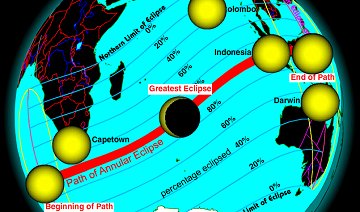The Year of the Ox is beginning with a solar eclipse. On Monday, Jan. 26th, the same new Moon that triggers the Chinese Lunar New Year will pass directly in front of the sun--dead center--covering 93% of the solar disk. The ensemble will form a stunning "ring of fire" visible across the Indian Ocean:

Click on the image, above, to launch an animated map of the eclipse prepared by graphic artist Larry Koehn. A regional map of Indonesia shows the best dry places to see the ring of fire: Borneo, Sumatra and Java.
Outside the narrow path of annularity, the Moon will cross the sun off-center, producing crescent suns of varying depth over south Africa, Madagascar, Australia, southern parts of India and southeast Asia. Sky watchers in those places should attend to the ground: crescent sunbeams will dapple the earth beneath leafy trees and garden latticework. Solar telescopes trained on the sky will show the Moon taking a bite out of the sun. Stay tuned for photos!

Today, a few lucky people may see a "ring of fire." That's a name for the central view of an annular eclipse of the Sun by the Moon. At the peak of this eclipse, the middle of the Sun will appear to be missing and the dark Moon will appear to be surrounded by the bright Sun. This will only be visible, however, from a path that crosses the southern Indian Ocean. From more populated locations, southern Africa and parts of Australia, most of the Moon will only appear to take a bite out the Sun. Remember to never look directly at the Sun even during an eclipse. An annular eclipse occurs instead of a total eclipse when the Moon is on the far part of its elliptical orbit around the Earth. The next annular eclipse of the Sun will take place in 2010 January, although a total solar eclipse will occur this July. Pictured above, a spectacular annular eclipse was photographed behind palm trees on 1992 January.
Bron: spaceweather/apod